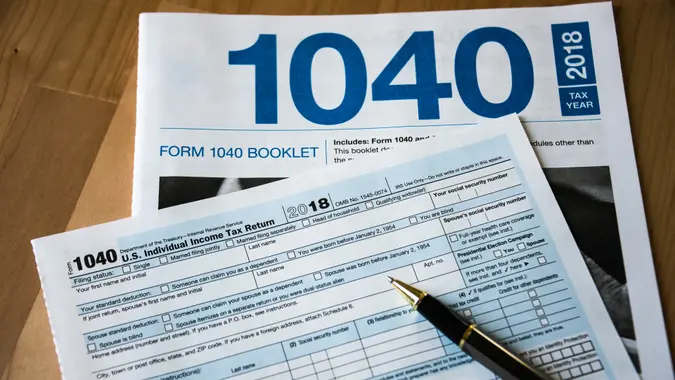Advertiser Disclosure
GOBankingRates works with many financial advertisers to showcase their products and services to our audiences. These brands compensate us to advertise their products in ads across our site. This compensation may impact how and where products appear on this site. We are not a comparison-tool and these offers do not represent all available deposit, investment, loan or credit products.
What Extending Trump’s Tax Cuts Would Mean for the Middle Class in 4 Battleground States
 Written by
J. Arky
Written by
J. Arky
 Edited by
Rebekah Evans
Edited by
Rebekah Evans

Commitment to Our Readers
GOBankingRates' editorial team is committed to bringing you unbiased reviews and information. We use data-driven methodologies to evaluate financial products and services - our reviews and ratings are not influenced by advertisers. You can read more about our editorial guidelines and our products and services review methodology.

20 YearsHelping You Live Richer

Reviewed by Experts

Trusted by Millions of Readers
As he campaigns to retake the White House, Donald Trump is rolling out a game plan for tax cuts in an attempt to lure voters over to his side, specifically in battleground states where the ballots could go either way.
“Assessing the Trump administration’s tax cuts from an economic standpoint is crucial when considering the middle class in key states,” said Hector Castaneda, CPA, principal at Castaneda CPA & Associates. “The extension of tax cuts could affect several key areas, such as inflation and cost of living, employment and wage growth and inequality in the distribution of benefits.”
Itay Simchi, founder of Proven House Buyers, added, “If Trump’s tax cuts were to be extended, I believe it would have a mixed impact on the middle class in battleground states.
On one hand, the tax cuts would likely lead to increased disposable income for middle-class households, allowing them to spend more on discretionary items like housing, entertainment and travel. This could boost local economies and stimulate growth.
“On the other hand, the extension of tax cuts would likely widen the wealth gap between the rich and the poor. The wealthiest individuals and corporations would benefit disproportionately from the tax cuts, while middle-class households might not see significant benefits due to their lower tax brackets.
“This could lead to increased income inequality and reduced social mobility.”
Extending Trump’s tax cuts could give people more money to spend, which might boost consumer spending but also cause inflation, according to Castaneda.
“This could lead to higher living costs, especially for housing where demand is high,” Castaneda explained. “How much wages increase compared to inflation and how governments and industries respond will determine the overall impact on the middle class.”
There are four battleground states which might lend a bigger picture to the tax cut extension proposed by Trump could mean for other states across the nation.
Ohio
“As a critical swing state in presidential elections, Ohio’s economy is heavily reliant on manufacturing and agriculture,” said Simchi.
With the tax cuts, Simchi predicted that Ohioans might see an increase in disposable income, leading to improved housing demand and potentially higher property values.
Pennsylvania
Healthcare, education and tourism are the lead industries that fuel the local economy of Pennsylvania.
“Tax cuts could lead to increased consumer spending on these sectors, benefiting local businesses and potentially boosting property values,” Simchi said.
Michigan
The automotive industry, which Michigan is famous for, has reported significant earnings in recent years, meaning that the state’s economy has found room to grow after decades of running in the red.
“Tax cuts could lead to increased investments in research and development, creating jobs and stimulating local economies,” Simchi said.
Florida
Florida is another state where the economy depends on two niche industries: tourism and retirement communities.
“With tax cuts, retirees might see increased disposable income, leading to higher demand for housing and potentially increased property values,” Simchi said.
Other States
Other battleground states — Wisconsin, Arizona and North Carolina — might experience different outcomes.
“Wisconsin’s economy is heavily reliant on manufacturing, which could benefit from increased investments,” Simchi said. “Arizona’s economy is driven by technology and healthcare, which might not be significantly impacted by tax cuts.
“North Carolina’s economy is diverse, with a strong presence of industries like finance and technology.”
Castenada said, “Over time, economic growth from the tax cuts might create tighter job markets, which could raise wages. The overall impact on the middle class will depend on how the benefits are distributed, the quality and stability of new jobs, and the local economy.
“Some states and industries might see significant gains, while others might experience only small or inconsistent changes.”
Simchi pointed out that extending Trump’s tax cuts could have a mixed impact on the middle class in battleground states.
“While it could lead to increased disposable income and economic growth in some areas,” he said, “it could also exacerbate income inequality and have unintended consequences on other sectors of the economy.”
Castaneda added that proposed tax cuts by Trump may have varying effects on various income levels, highlighting that one of the main criticisms leveled at these tax cuts is that they mostly help corporations and wealthy individuals.
“Richer people receive larger tax breaks, both in the overall amount and as a percentage of their income,” Castaneda stated. “Due to this, benefits for middle-class and lower-class groups may be reduced, which will increase income inequality.
“Budget cuts could harm middle-class and lower-class families, who rely more on public services like healthcare and education, putting aside the tax cut’s positive effects.”
While there is no exact way to chart out what will happen in these states or the rest of America, there are a couple of different ways that expanding Trump’s tax cuts might impact the middle class.
“Even though there’s a chance for economic expansion and more money to spend, not everyone will benefit equally, which could worsen income inequality,” Castaneda said. “The quality of life of the middle class may suffer as a result of problems with state budgets and public services. More jobs may be created, but we don’t know how good they will be. Inflation and rising living expenses may also make matters more difficult.”
Editor’s note on election coverage: GOBankingRates is nonpartisan and strives to cover all aspects of the economy objectively and present balanced reports on politically focused finance stories. You can find more coverage of this topic on GOBankingRates.com.
More From GOBankingRates
Share This Article:




You May Also Like



What Trump's New Tax Law Means for Upper-Middle-Class Families in 2025
September 22, 2025
6 min Read

Kevin O'Leary: Here's What You Need To Know About Trump's New Tax Bill
September 23, 2025
6 min Read

I Asked ChatGPT What Would Happen If Middle-Class Families Got the Same Tax Breaks as Corporations
September 18, 2025
6 min Read


I Asked ChatGPT What Would Happen If Billionaires Paid Taxes at the Same Rate as the Working Class
September 24, 2025
6 min Read

I Asked ChatGPT What Would Happen If Billionaires Paid Taxes at the Same Rate as the Middle Class
September 18, 2025
6 min Read


'New Round of Stimulus Checks' -- 7 Changes to 2026 Taxes You Need to Know
September 17, 2025
6 min Read

Trump Closed a Tariff Loophole That Was Saving You Thousands -- 4 Things You Need To Know
September 15, 2025
6 min Read

Last Chance for $7,500 EV Tax Credit: Loophole Sidesteps OBBBA Deadline
September 16, 2025
6 min Read

What Trump's New Tax Law Means for Upper-Middle-Class Families Beyond 2025
September 15, 2025
6 min Read
Make your money work for you
Get the latest news on investing, money, and more with our free newsletter.
By subscribing, you agree to our Terms of Use and Privacy Policy. Unsubscribe at any time.


Thanks!
You're now subscribed to our newsletter.
Check your inbox for more details.



Sending you timely financial stories that you can bank on.
Sign up for our daily newsletter for the latest financial news and trending topics.
For our full Privacy Policy, click here.
Looks like you're using an adblocker
Please disable your adblocker to enjoy the optimal web experience and access the quality content you appreciate from GOBankingRates.
- AdBlock / uBlock / Brave
- Click the ad blocker extension icon to the right of the address bar
- Disable on this site
- Refresh the page
- Firefox / Edge / DuckDuckGo
- Click on the icon to the left of the address bar
- Disable Tracking Protection
- Refresh the page
- Ghostery
- Click the blue ghost icon to the right of the address bar
- Disable Ad-Blocking, Anti-Tracking, and Never-Consent
- Refresh the page





